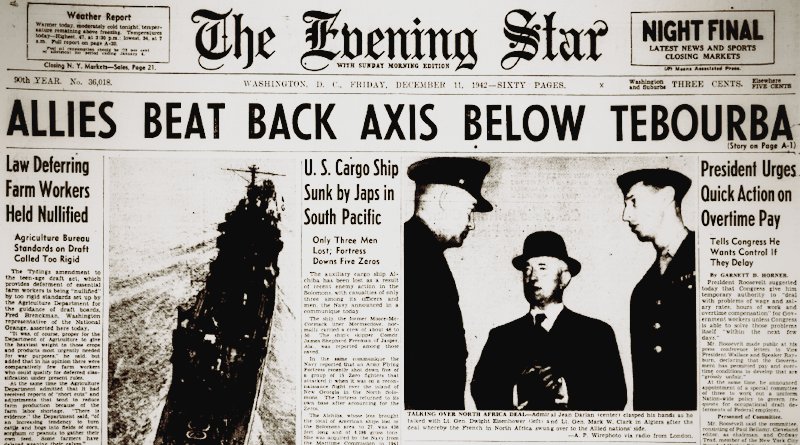World War II Chronicle: December 11, 1942
Click here for TODAY’S NEWSPAPER
The cruiser USS San Francisco is pictured on the front page steaming under the Golden Gate Bridge, bearing scars from battle in the Solomons. Also pictured is generals Dwight Eisenhower and Mark Clark, conferring with French admiral Jean Darlan in North Africa… Two-time All-American Yale halfback Clint Frank1Frank is enshrined in the College Football Hall of Fame in 1955 now serves as aide to Maj. Gen. Jimmy Doolittle (see page seven)…
Page 41 tells of Ensign Jefferson H. “Tiny” Carroum, an SBD Dauntless pilot who swam for three days before reaching land. Carroum was just under the height requirement but was able to join due to his excellent physical condition and eyesight… Sports begins on page 49, and features the 1942 All-American college football selections…
Roving Reporter by Ernie Pyle
WITH THE AMERICAN FORCES IN ALGERIA — At the end of the first day of the Battle of Oran Sergt. Norman Harrington and Pvt. Ned Modica, Army photographers, sprawled on the floor of a country schoolhouse near the little Algerian town of Arzew. Other soldiers lay all around them.
Both were dead tired. They had been on the go all day without stopping, running up and back, ditching extra equipment and returning later to get it.
Their clothes were still wet, and they were cold. They had come ashore without blankets or overcoats. Instead of one musette bag, they carried three over their shoulders. These weren’t filled with food or ammunition. They were filled with extra film for their cameras.
And of cameras they had aplenty. Ned carried two movie color cameras and one still camera. Norman lugged a huge newsreel job and a still camera. Of personal things they carried only toothbrushes.
Norman Harrington’s father is a preacher. He was gassed in the last war. Today he is living in retirement in Florida, a sick man from the holocaust of 25 years ago.
The other was was an old thing by the time Norman grew to adult consciousness, and he heard little about it from his father.
Norman wasn’t much interested in wars, anyway. He was a civic leader back home in Easton, Md. — an odd thing for a boy of 16 just out of high school. He was chairman of the March of Dimes for the President’s birthday. He belonged to clubs. He made luncheon talks. He had an uncanny head for business, and he was wedded to photography.
Norman and Ned, in their first 12 hectic hours on African soil, had filmed wounded Americans and wounded Frenchmen, filmed the actual capture of a seaplane base, and had a weird experience filming their first wartime corpse, the body of a sniper who had shot at them and missed.
They slept little that first night. Snipers’ bullets pinged the walls and thumped into the yard.
The soldiers in the schoolroom were nervous all night. In the darkness they could hear the click of cartridge clips in revolvers. Just before dawn one touchy doughboy heaved a hand grenade out of the window at an imagined shadow.
One of the bunch sat all night telling endless anecdotes about his fraternity days in college.
Ned Monica was used to nicer things in life. As a youth he went to the New York School of Fine and Applied Arts. Then he had two years of study in Paris. His Long Island home is white brick, and his flowers are a riot of color against the green of his lawn. His studio was in fashionable Madison Avenue.
Now all his fine equipment is in storage. His wife still teaches school and keeps the home going. At dawn the two photographers luckily found a jeep and they drove forward to where the fighting for St. Cloud was going on. Eventually they left the jeep and worked their way up to the front line. In the Infantry you learn to walk a little, then to lie down and wait for a mortar shell to burst. Your head jerks down involuntarily when you hear the zing of a passing bullet. These two boys learned all that.
Ned Monica found an American machine gun crew, and ground away at them with his camera. It was good action stuff.
Then they went on into Oran and filmed the dramatic welcome given the American troops by the French and Arab people. Finally they boxed up their film, scouted around till they found an accommodating RAF pilot to fly it to London, and called it a day on their first venture into war.
Today they are bivouacked a score of miles out in the country living in tiny shelter tents in an olive grove, waiting for the next campaign. That’s where I found them.
“Here in Africa is the first place I ever picked an orange off a tree,” says Modica. “After our film is edited and censored it should still be enough for a 30-minute newsreel, most of it in technicolor,” says Harrington. “It should be beautiful.”
“When we get to Italy we can get us some wonderful things to eat,” says Modica. “At least we can ask for them, for I can speak Italian.”
“You;ll get to Italy and lots of other places,” says Harrington. “We’re going to be the beach-busters of every landing and be in on every kill. You’ll see.”
“When it’s all over I’m going to get discharged in Paris and have my wife take a sabbatical leave,” says Modica. “We’ll do these countries as tourists.
“You’ll be in China by the time it’s all over,” says Harrington
“Well, I’ve always wanted to see China, so we might as well get discharged there,” says Modica
“If we live that long,” says Harrington.
Evening star. (Washington, D.C.), 11 December 1942. Chronicling America: Historic American Newspapers. Lib. of Congress.
https://chroniclingamerica.loc.gov/lccn/sn83045462/1942-12-11/ed-1/
